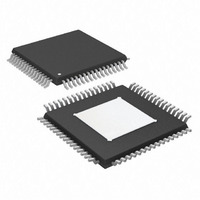AD7763BSVZ Analog Devices Inc, AD7763BSVZ Datasheet - Page 19

AD7763BSVZ
Manufacturer Part Number
AD7763BSVZ
Description
IC ADC 24BIT S/D 625KSPS 64-TQFP
Manufacturer
Analog Devices Inc
Datasheet
1.AD7763BSVZ-REEL.pdf
(32 pages)
Specifications of AD7763BSVZ
Data Interface
Serial, SPI™
Number Of Bits
24
Sampling Rate (per Second)
625k
Number Of Converters
1
Power Dissipation (max)
955.5mW
Voltage Supply Source
Analog and Digital
Operating Temperature
-40°C ~ 85°C
Mounting Type
Surface Mount
Package / Case
64-TQFP Exposed Pad
Resolution (bits)
24bit
Input Channel Type
Differential
Supply Voltage Range - Analogue
2.375V To 2.625V, 3.15V To 5.25V, 4.75V To 5.25V
Supply Voltage Range -
RoHS Compliant
Sampling Rate
625kSPS
Rohs Compliant
Yes
Lead Free Status / RoHS Status
Lead free / RoHS Compliant
Available stocks
Company
Part Number
Manufacturer
Quantity
Price
Company:
Part Number:
AD7763BSVZ
Manufacturer:
ADI
Quantity:
159
Company:
Part Number:
AD7763BSVZ
Manufacturer:
Analog Devices Inc
Quantity:
10 000
Company:
Part Number:
AD7763BSVZ-REEL
Manufacturer:
Analog Devices Inc
Quantity:
10 000
CLOCKING THE AD7763
The AD7763 requires an external, low jitter clock source. This
signal is applied to the MCLK pin, and the MCLKGND pin is
used to sense the ground from the clock source. An internal
clock signal (ICLK) is derived from the MCLK input signal.
The ICLK controls the internal operations of the AD7763. The
maximum ICLK frequency is 20 MHz, but due to an internal
clock divider, a range of MCLK frequencies can be used. There
are two ways to generate the ICLK:
This option is pin selectable (Pin 58). On power-up, the default
is ICLK = MCLK/2 to ensure that the part can handle the maxi-
mum MCLK frequency of 40 MHz. For output data rates equal to
those used in audio systems, a 12.288 MHz ICLK frequency can
be used. As shown in Table 6, output data rates of 192 kHz, 96 kHz,
and 48 kHz are achievable with this ICLK frequency. As mentioned
previously, this ICLK frequency can be derived from different
MCLK frequencies.
The MCLK jitter requirements depend on a number of factors
and are determined by
Where:
OSR = oversampling ratio =
f
SNR (dB) = target SNR.
EXAMPLE 1
This example is taken from Table 6, where:
ODR = 625 kHz.
f
f
SNR = 108 dB.
This is the maximum allowable clock jitter for a full-scale,
250 kHz input tone with the given ICLK and output data rate.
IN
ICLK
IN
= maximum input frequency.
(maximum) = 250 kHz.
= 20 MHz.
ICLK = MCLK ( CDIV = 1)
ICLK = MCLK /2 ( CDIV = 0)
t
t
j
j
(
(
rms
rms
)
)
=
=
2
2
×
×
π
π
×
×
f
IN
250
OSR
×
10
32
×
SNR
10
ODR
f
20
ICLK
3
(
dB
×
)
10
.
6
=
3
6 .
ps
Rev. A | Page 19 of 32
EXAMPLE 2
Following is a second example from Table 6, where:
ODR = 48 kHz.
f
f
SNR = 120 dB.
The input amplitude also has an effect on these jitter figures.
If, for example, the input level is 3 dB below full scale, the allowable
jitter is increased by a factor of √2, increasing the first example
to 2.53 ps rms. This happens when the maximum slew rate is
decreased by a reduction in amplitude. Figure 29 and Figure 30
illustrate this point, showing the maximum slew rate of a sine
wave of the same frequency but with different amplitudes.
ICLK
IN
(maximum) = 19.2 kHz.
Figure 29. Maximum Slew Rate of Sine Wave with Amplitude of 2 V p-p
= 12.288 MHz.
t
–0.5
–1.0
–0.5
–1.0
j
1.0
0.5
1.0
0.5
Figure 30. Maximum Slew Rate of Same Frequency Sine Wave
(
rms
0
0
)
=
2
×
π
×
19
with Amplitude of 1 V p-p
2 .
256
×
10
3
×
10
6
=
133
ps
AD7763













